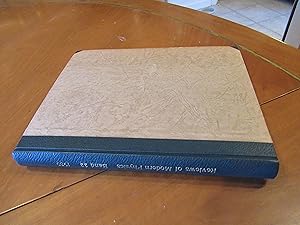John Tate Charles Lauritsen Rabi (1 results)
Product Type
- All Product Types
- Books (1)
- Magazines & Periodicals
- Comics
- Sheet Music
- Art, Prints & Posters
- Photographs
- Maps
-
Manuscripts &
Paper Collectibles
Condition
- All Conditions
- New
- Used
Binding
- All Bindings
- Hardcover
- Softcover
Collectible Attributes
- First Edition
- Signed
- Dust Jacket
- Seller-Supplied Images
- Not Printed On Demand
Seller Location
Seller Rating
-
Reviews Of Modern Physics, Volume 22, 1950, Including "Recent Investigation Of The Shapes Of Beta-Ray Spectra" By Chien-Shiung Wu
Published by American Physical Society / American Institute Of Physics, 1950
Seller: Arroyo Seco Books, Pasadena, Member IOBA, Pasadena, CA, U.S.A.
Association Member: IOBA
Book First Edition
Hardcover. Condition: Near Fine. 1st Edition. 422 Pp. Annual Volume 1950, Bound With Green Morocco Spine And Tips, No Wrapers. Patterned Boards, Speckled Edges, Gilt Title On Spine. Near Fine, No Wear, Immaculate, Gilt Brilliant, "Hauptbucherel" Stamp And Circular Ownership Stamp In Ludwigshafen On Title Page, Vertical Crease On Title Page, Else Fine. Chien-Shiung Wu (Chinese: ???; 1912 ? 1997) Was A Chinese-American Particle And Experimental Physicist Who Made Significant Contributions In The Field Of Nuclear And Particle Physics. Wu Worked On The Manhattan Project, Where She Helped Develop The Process For Separating Uranium Into Uranium-235 And Uranium-238 Isotopes By Gaseous Diffusion. She Is Best Known For Conducting The Wu Experiment, Which Proved That Parity Is Not Conserved. This Discovery Resulted In Her Colleagues Tsung-Dao Lee And Chen-Ning Yang Winning The 1957 Nobel Prize In Physics, While Wu Herself Was Awarded The Inaugural Wolf Prize In Physics In 1978. Her Expertise In Experimental Physics Evoked Comparisons To Marie Curie. Her Nicknames Include The "First Lady Of Physics", The "Chinese Madame Curie" And The "Queen Of Nuclear Research". In September 1944, Wu Was Contacted By The Manhattan District Engineer, Colonel Kenneth Nichols. Wu Was Frustrated With Her Lack Of Professorships And Volunteered To Help Out In The Project. The Newly Commissioned B Reactor, The First Practical Nuclear Reactor Ever Built, Which Was Located At The Hanford Site Had Run Into An Unexpected Problem, Starting Up And Shutting Down At Regular Intervals. John Archibald Wheeler And Partner Enrico Fermi Suspected That A Fission Product, Xe-135, With A Half-Life Of 9.4 Hours, Was The Culprit, And Might Be A Neutron Poison Or Absorber. Segrč Then Remembered The 1940 Phd Thesis That Wu Had Done For Him At Berkeley On The Radioactive Isotopes Of Xe And Told Fermi To "Ask Ms. Wu". After Fermi Contacted Wu, Segrč Visited Her Dorm Room Together With Nichols And Collected The Typewritten Draft Prepared For The Physical Review. The Suspicions Of Fermi And Wheeler Came True, Wu's Paper Unknowingly Verified That Xe-135 Was Indeed The Culprit For The B Reactor; It Turned Out To Have An Unexpectedly Large Neutron Absorption Cross-Section. Wu Also Used Her Findings In Radioactive Uranium Separation To Build The Standard Model For Producing Enriched Uranium To Fuel The Atomic Bombs At The Oak Ridge, Tennessee Facility As Well As Build Innovative Geiger Counters. Wu, Like Most Involved Physicists In Their Later Years Distanced Herself From The Manhattan Project Due To Its Destructive Outcome And Recommended To The Taiwanese President Chiang Kai-Shek In 1962 To Never Build Nuclear Weapons. In November 1949, Wu Experimented With The Conclusions Of Einstein's Epr Thought Experiment, Which Called Quantum Entanglement "Spooky Action At A Distance". Wu Managed To Be The First To Establish The Phenomenon And Validity Of Entanglement Using Photons Through Observing Angular Correlation. Specifically, The Experiment Carried Out By Wu Was The First Important Confirmation Of Quantum Results Relevant To A Pair Of Entangled Photons As Applicable To The Einstein-Podolsky-Rosen (Epr) Paradox. In Her Post-War Research, Wu Continued To Investigate Beta Decay. In 1949, Wu Completely Established Fermi's Theory And Showed How Beta Decay Worked, Especially In Creating Electrons, Neutrinos, And Positrons.At Columbia, Wu Knew The Chinese-Born Theoretical Physicist Tsung-Dao Lee Personally. In The Mid-1950S, Lee And Another Chinese Theoretical Physicist, Chen Ning Yang, Grew To Question A Hypothetical Law Of Elementary Particle Physics, The "Law Of Conservation Of Parity". The Discovery Of Parity Violation Was A Major Contribution To Particle Physics And The Development Of The Standard Model. The Discovery Actually Set The Stage For The Development Of The Model, As The Model Relied On The Idea Of Symmetry Of Particles And Forces And How Particles Can Sometimes Break That Symmetry. (See The Much Longer Wikipedia Article).


